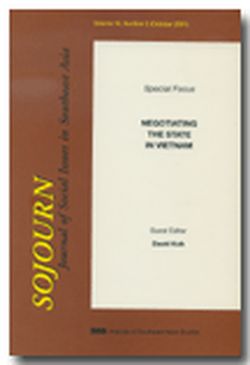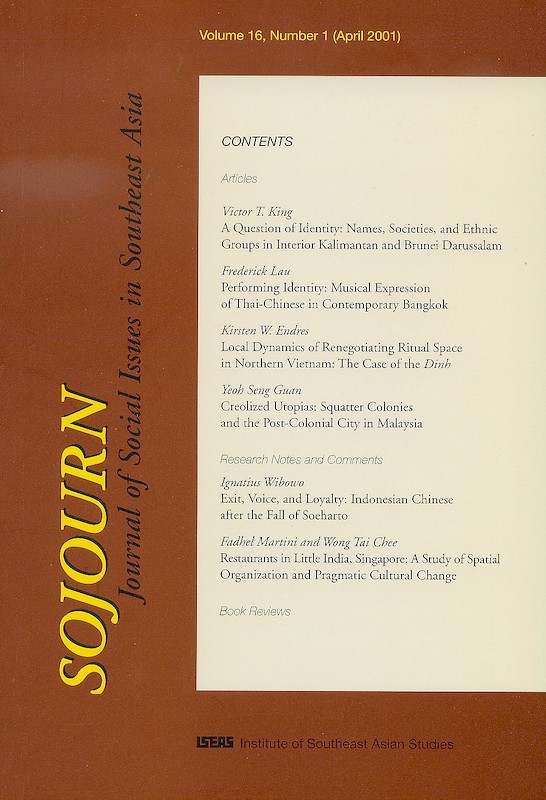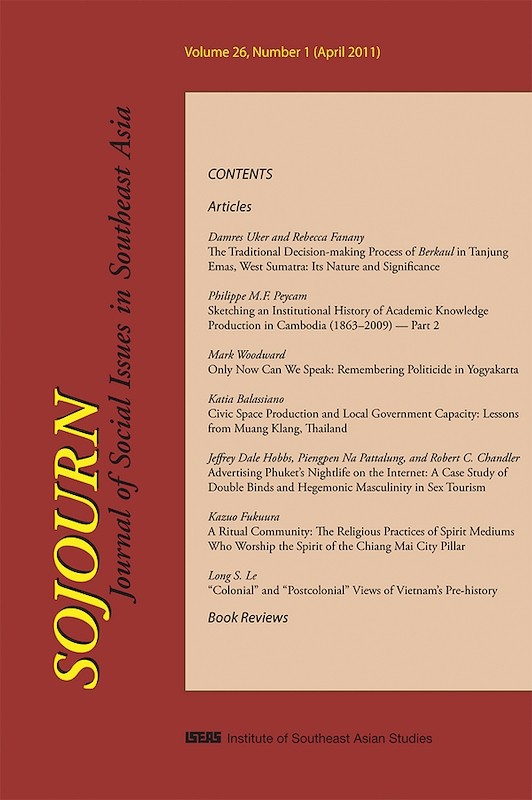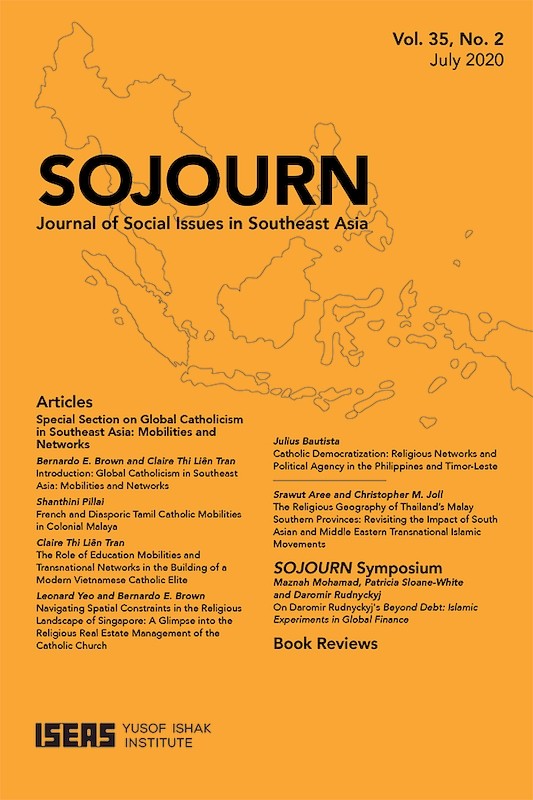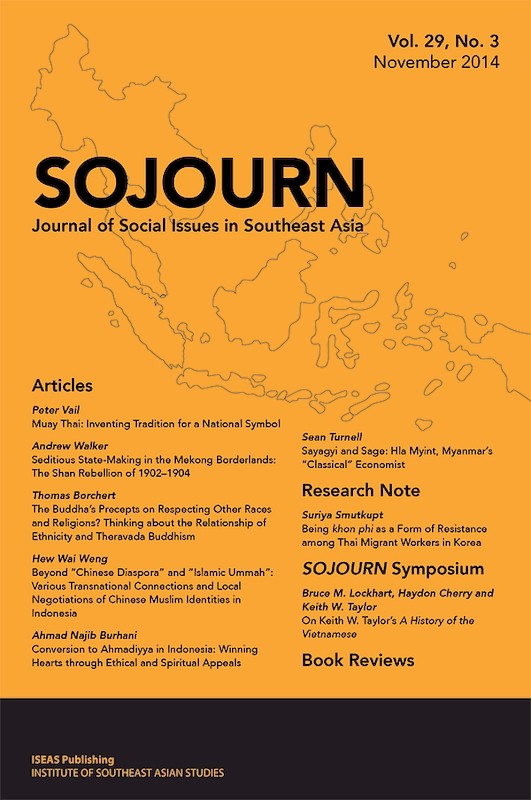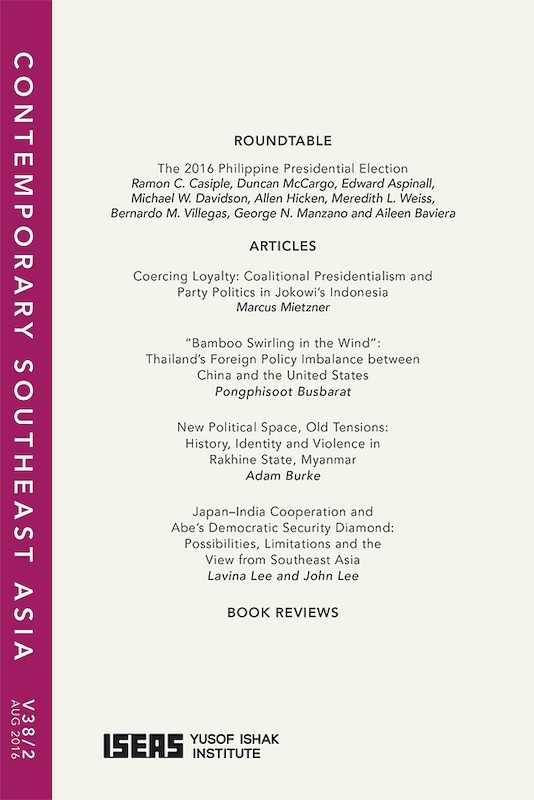SOJOURN: Journal of Social Issues in Southeast Asia Vol. 25/2 (October 2010)
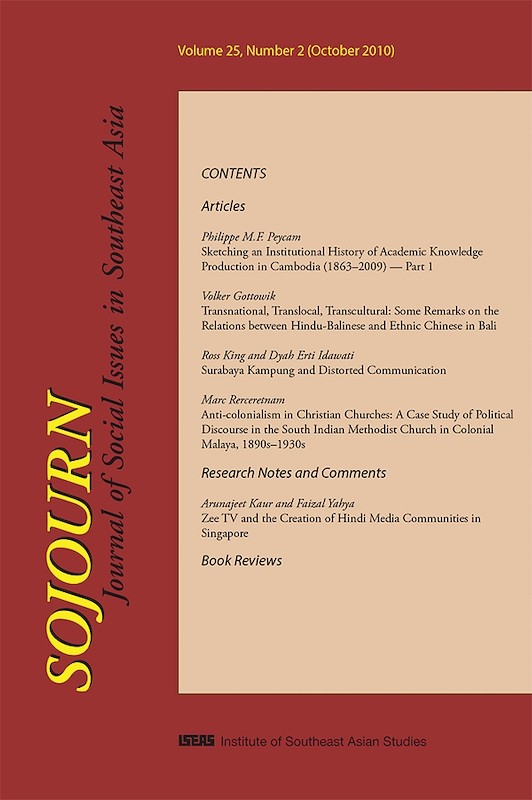
Date of publication:
October 2010
Publisher:
Institute of Southeast Asian Studies
Number of pages:
148
Code:
SJ25/2
Contents
-
SOJOURN: Journal of Social Issues in Southeast Asia Vol. 25/2 (October 2010)
[Whole Publication] -
Preliminary Pages
- ARTICLES
-
Sketching an Institutional History of Academic Knowledge Production in Cambodia (1863-2009), by Philippe Peycam, author see abstractThis paper focuses on the institutional mode of academic knowledge production in Cambodia since the beginning of the colonial period. It addresses the importance of French official orientalism represented by the Ecole Franaise d'Extrme-Orient and its role in constructing a reified narrative of the nation state of Cambodia centred on the Angkorian "golden age" while orientating intellectual "modernization" through the renovation of Buddhism. This top-down approach was pursued by the successive post-independence regimes -- to the exclusion of the Khmer Rouge who systematically destroyed Cambodia's intellectual and cultural life. In contradiction with state initiatives, a few researchers mostly French and Cambodians -- chose to orientate their research toward ethnographically relevant subjects, taking Cambodian society as principal agent of cultural and historical meaning. This trend, referred to as "Khmer studies", found its programmatic autonomy among exiled Cambodian intellectuals in the 1980s, paving the way for grass-root initiatives developed in Cambodia in the wake of its reopening in the 1990s.
-
Transnational. Translocal, Transcultural: Some Remarks on the Relations between Hindu-Balinese and Ethnic Chinese in Bali, by Volker Gottowik, author see abstractIn the course of the spatial turn in the social sciences, new terms and categories have emerged. This paper applies categories like translocal and transcultural to the way the Hindu-Balinese perceive themselves in order to bring out certain principles of their ethos and world view. This world view is symbolically expressed through a pair of black and white figures, Barong Landung, who are venerated as sacred by many Hindu-Balinese and perceived as representing their first ancestors or Kawitan. This multiethnic couple reminds the Hindu-Balinese that their origin as a people lies outside their island, that their religion derives from India, and that parts of their culture once came from China. Against the background to this rather global self-understanding of a local culture, the paper asks how the Hindu-Balinese define their relations with the ethnic Chinese in Bali.
-
Surabaya Kampung and Distorted Communication, by Ross King, Dyah Erti Idawati, authors see abstractIn 2002, kampung communities on the Kali Wonokromo riverbank were forcibly evicted and their kampungs cleared on the declared grounds of flood mitigation. The clearance, however, coincided with a programme of re-imagining the city as a green and waterfront global city. These events led other riverbank kampungs into a new (and "un-Indonesian") form of coalition of resistance which, moreover, adopted its own strategies of re-imagining. There was, in effect, a "distortion" of communication on both sides of the conflict. The subsequent events have thrown some light on aspects of Jrgen Habermas's notions of manipulation and distorted communication.
-
Anti-colonialism in Christian Churches: A Case Study of Political Discourse in the South Indian Methodist Church in Colonial Malaya, 1890s-1930s, by Marc James Rerceretnam, author see abstractThis paper will highlight attitudes to British colonialism among some middle-class Indian Christian communities and will use as a case study the anti-colonial discourse within the Methodist Church. It will illustrate how diverse shades of political resistance existed among this Church community despite fears of state retribution. Discourses such as Dravidian Nationalism, Eastern Nationalism, and even the Methodist Church itself were influential in creating oppositional space and fostering intellectual freedom at a time when such expressions were frowned upon. This study thus challenges the perception that middle-class Indian communities were so pro-British that others often derogatorily referred to them as "Black Europeans".
- RESEARCH NOTES AND COMMENTS
-
Zee TV and the Creation of Hindi Media Communities in Singapore, by Arunajeet Kaur, Faizal Yahya, authors see abstractIndian communities in Singapore, especially of non-Tamil sub-ethnicity, have received renewed impetus to replenish their cultural ties with India as a homeland with the advent of Hindi Cable channels such as Zee TV, Sony Entertainment, and Star Plus. The availability of cable networks in the early 1990s and the proliferation of Hindi media channels have led to a renaissance of Hindi culture, fashion, cuisine, custom, and ritual among the Indian communities in Singapore. Timed against the background of India Rising, this has also fueled the impetus for Hindi speaking communities in Singapore to travel back to India to witness locations that have been included in the shooting of soaps, shop for specific fashion items introduced via the cable, participate in pilgrimage locations, and donate towards political and social causes that affect India. The Hindi cable channels have created new diasporic spheres that facilitate a sense of belonging with the homeland which was previously unimaginable.
- BOOK REVIEWS
-
BOOK REVIEW: Privatization in Malaysia: Regulation, Rent-seeking, and Policy Failure by Jeff Tan, by Lee Hwok-Aun, author
-
BOOK REVIEW: Colonialism, Violence and Muslims in Southeast Asia: The Maria Hertogh Controversy and its Aftermath by Syed Muhd Khairudin Aljunied, by Loh Kah Seng, author
-
BOOK REVIEW: Exploring Ethnic Diversity in Burma edited by Mikael Gravers, by Bruce Matthews, author
-
BOOK REVIEW: Things Fall Away: Philippine Historical Experience and the Makings of Globalization by Neferti XM Tadiar, by Yeoh Seng Guan, author

